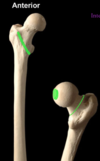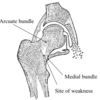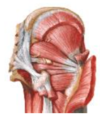7.15 Joints of the Hip Flashcards
How many joints are involved in the hip?
One
A ball and socket
Compare the hip ball and socket joint to the one of the shoulder (glenohumeral joint)
The socket is deeper than the glenoid fossa of the shoulder (which is designed for mobility). The hip has much more stability
What are the three components of the hip bone?
- Ileum
- Ischium
- Pubis

What and where is the acetabulum?
It is the socket component of the hip bone

Each component of hip bone (ileum, ischium & pubis) helps form acetabulum.
Is all the acetabulum an articular surface?
No
There are 2 parts to the acetabulm
- A lunate surface is the semicircular surface that is the weight bearing region and articular with the femur
- The acetabular notch & fossa are in the centre and are non- articular. This is roughened bone i with exposed trabeculae

Describe the congruence of the three parts of the hip bone
The converge to each contribute (unequally) to the acetabulum.
They converge very well into a ‘Y’ shaped area of congruence and fuse (epiphysis) in late puberty
What is the acetabular notch?
What fills this notch?
A depression in the margin of the acetabulum located anteroinferiorly.
It is bridged by a transverse ligament

What is located deep in the socket and fills irregularities in the hip joint socket/acetabulum?
A fat pad
Intra-articular but extra-synovial fat that has both a nerve and blood supply (source of pain and bleeding) and is also important in spreading the synovial fluid.

Where is the acetabulum ligament coming from?
What function does it serve?
From a depression in the head of the femur (called the fovea). The ligament that goes into the acetabulum.
- It is an intraarticular structure in the joint
- It doesn’t have much other function
Label the major parts of the proximal femur
- Head (with the fovea)
- Anatomical neck
- Greater and lesser trochanter
- The intertrochanteric line
- The shaft

Describe the joint capsule of the hip, especially in terms of where it attaches to
The capsule of the hip bone attaches to the anatomical neck only in utero.
After birth…
- Anteriorly, it migrates distally towards the intertrochanteric line
- Posteriorly it stays near the anatomical neck (migrates slightly distally)

What is contained in the Vascular foraminae of the head of the femur?
These are holes in the bone that enable the passage of blood vessels (around the neck of the femur)
Describe what type of epiphysis the greater and lesser trochanters are
Both trochanters are traction epiphyses which fused and formed due to the pull of muscles/ligaments.
The greater trochanter fuses in mid-teens.

What other kind of epiphysis is present in the head of the femur? Describe its location and formation
A pressure epiphyses - the weight bearing epiphyses also called the capital epiphyses
Dependent on an adequate blood supply getting to that part of the bone.

Describe Perthe’s Disease
When a change (loss) in blood supply potentially affects development of the capital epiphysis of the head of the femur
It causes avascular necrosis of head of femur due to interuption of blood supply
The bone can take between two and five years to re-grow. Perthes’ disease is also known as Legg-Calve-Perthes disease or coxa plana.

Describe the orientation of the large fossa of the head of the femur
It is 2/3 of a sphere
It is directed upwards, medially & forwards (the anterior most part lies outside the acetabulum)
If the anterior most part of the head of the femur lies outside the acetabulum, how is it protected?
By the psoas bursa
It lies deep to the primary flexor of the hip (ileopsoas muscle before articulates to the lesser trochanter).

The roof of the acetabulum is the region that has the thickest cartilage.
Why is this?
This is the primary area of articulation of the head of the femur - where most of the weight bearing is occuring

What enables a greater range of motion of the hip joint?
There is a narrowing in the mid-region of the femoral neck (it is narrower than circumference of head)
This means that there is a range of motion that can be achieved without the bone making contact with the acetabulum and this increasing ROM

How are trabecular patterns of cancellous bone formed?
There is a trabecular pattern of growth that follows the course of stress (weight) lines along the bone. Maximum trabeculae develop along the lines of maximum stess.
Describe the boney architecture of the head of the femur
In the head of the femur there are two main intersecting trabecular systems:
- SUPERIOR: medial bundle & arcuate bundle – formed due to the compression through head & neck
- INFERIOR: medial bundle & lateral bundle – formed in response to muscle pulls on greater & lesser trochanters

Where is the fracture risk in relation to the trabecular patterns?
Where the two main trabecular patterns intersect




















